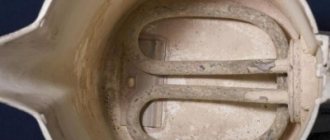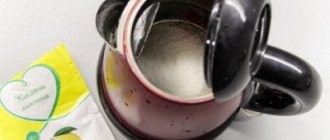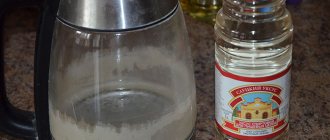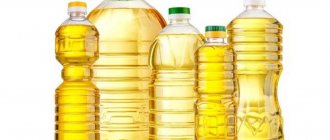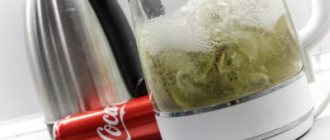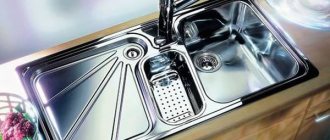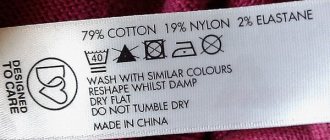Scale and rust in a kettle are a phenomenon that absolutely everyone who uses this kitchen creature encounters. They appear due to the high content of salts and minerals in tap water. Even if you use purchased water, you cannot get rid of this problem. Therefore, it is not surprising that many are interested in how to clean a stainless steel kettle from scale?
Lime in the kettle
What is scale and why is it harmful?
The sediment formed during boiling can have a different composition. It depends on the water that is used. The composition may include organic and inorganic impurities, sulfates, silicates, carbonates. Scale is a set of chemical compounds that negatively affect both equipment and the body:
- Negative impact on equipment. The rate of layer growth depends entirely on the liquid used, the quality of the surface and the heating element. Immediately after purchasing new equipment, the rate of deposit formation is low, but after several rough cleanings of the surface using aggressive agents, it increases significantly. Formations negatively affect the boiling speed, more energy is consumed. Limescale can also lead to overheating and burning of equipment.
- Harm to health. The emerging layer contains many different elements. Despite the fact that our body needs them, we need to consume them in the required quantity. Drinking water from a kettle with a large layer of scale leads to oversaturation of the body with certain elements. This is fraught with clogging of blood vessels and the deposition of kidney stones. In addition, porous surfaces are an ideal breeding ground for various harmful bacteria.
All this indicates that it is necessary to carefully and regularly clean surfaces from accumulations of deposits. However, it must be correct and not harm the heating elements and surfaces.
Cleaning products
Principles of cleansing at home
Tips for caring for stainless steel are very simple. They are easy to follow.
What not to use
List of products and devices that should not be used when using stainless steel cookware:
- Dishwasher;
- metal sponge;
- a cleaner containing abrasive components.
How to use baking soda and salt
Salt and soda are essential care products for stainless steel cookware. The principle of their use is simple:
- the product is washed;
- apply soda, salt or a mixture thereof to the contaminated area;
- rub the powder in a circular motion.
After cleaning, the item is rinsed with water and dried with a towel.
Timeliness
Regular cleaning of stainless steel pans eliminates the appearance of old stains. It takes little time to remove fresh stains.
To avoid divorces
After each wash, wipe the dishes dry with a kitchen towel. There are no streaks on a clean, dry surface.
Anti-scale products
Anti-scale products
The modern market offers many different products that effectively combat this problem. However, their price is not always justified. Therefore, many housewives are looking for an alternative to such products. Among the most popular, it is necessary to highlight several:
- lemon acid;
- vinegar;
- brine;
- potato peelings;
- soda;
- Pepsi or Coca-Cola.
But not all of these folk remedies are effective and can quickly deal with scale. Let's look at how to effectively clean a stainless steel kettle using folk remedies that every housewife can find in her home.
How to Clean Effectively
Chemicals that are safe to use
Glutoclean
If you want to clean the kettle, you can consider washing powder and other detergents. In the store you will find liquid Glutoclean on the counter. It does not irritate the respiratory tract or eyes; you can work without gloves. The recipe is simple, you just need to apply a little product on a cotton swab and clean it.
The FINISH cleaner is being considered as a substitute. It is sold in 250 ml packs and is also liquid. FINISH fights salt deposits and additionally removes fat. No harm is done to the metal surface. Additional advantages include the absence of a pungent odor; it is washed off without problems.
Interesting! In addition to metal, the product will also clean glass and plastic.
The substance is unique because it contains active substances. Additionally, it is possible to combat unpleasant odors. After use, it is recommended to rinse the kettle well and wipe it with a dry cloth.
If you go through laundry detergents, Calgon is used. It is sold at an affordable price; there is no need to look for substitutes. In terms of dosage, it is recommended to use portions of 25-30 grams. The container is simply filled with water and then you have to work a little with a brush or napkin. The scale is removed after the first procedure.
Calgon powder
If we talk about the composition, it contains zeolites, endogenous substances and carboxylic acids. The washing powder is universal, suitable for various types of surfaces. The product is phosphate-free, so it does not harm human health.
A Dutch manufacturer produces HG cleaner in liquid form. The basis is citric acid plus water. 500 ml products are considered common. The method of application is extremely simple; you will need 75 ml of solution and approximately 700 ml of water. The liquid is poured into the kettle and left for about 10 minutes. There is no need to rub the bottom or walls, citric acid will do everything itself.
If you are considering additional phosphate-free products, it is recommended that you do not pass by Astonish products. It is suitable for cleaning teapots made of metal and stainless steel. Where vinegar and citric acid cannot cope, you can safely take this concentrate. It targets scale exclusively and is easy to use.
In terms of dosage, it is necessary to take into account the capacity of the kettle. If you use a 30 ml cap, you will need half a liter of water. This mixture must be poured into a kettle and rubbed over problem areas. Among other features, there is no odor. The product will get rid of limescale and fights calcium and mineral deposits.
If you consider economical means, you can get Tiret products in stores. This is a Russian manufacturer that has been on the market for a long time. The peculiarity of this cleaner is the use of citric acid. Active substances are used as a basis and there are no additives. Despite this, it is recommended to work with gloves; the product does not allow high temperatures.
The smell is quite tolerable, a fragrance is provided. If you look at the packaging, the descaling product is sold in containers of 250-500 ml. The temperature range is indicated on the product; you need to pay attention to the expiration date. As for application, you need to take a capful of liquid, add 500 ml of water and boil for about 3 minutes.
Citric acid anti-scale
Citric acid against scale
Citric acid is the most effective, but aggressive method for descaling a kettle. With its help, you can quickly remove even the most stubborn formations. In order to start cleaning, you need to take citric acid, its amount depends entirely on the degree of scale. You need to take two bags of citric acid and pour them inside. Then add enough water to cover all the dirt. The kettle should be boiled several times with a break of a couple of minutes. All deposits will dissolve in water. After cleaning, you need to rinse the kettle with detergent and pour water into it so that it is full and put it to boil. This cleaning product is equally effective for both electric and gas-fired kettles.
Important! After such cleaning, the kettle must be rinsed thoroughly and boiled several times so that no acid particles remain in it.
Helpful information
A stainless steel kettle is a durable device, but if not properly cared for, even it can be damaged. To prevent this from happening, you need to adhere to the following recommendations:
Do not use a hard wire brush to remove limescale. Do not try to scrape off scale with a knife or other sharp tools.- When using professional cleaners, strictly follow the instructions. Do not leave them in the appliance longer than indicated on the packaging.
- Do not attempt to remove scale using caustic acids.
After completing the processing, be sure to boil the kettle using clean water. You can't drink it. The first liquid must be drained.
You will find a lot of useful information about descaling here.
Cleaning with vinegar
Table vinegar is also an effective remedy. Many people write that you can use both apple juice and regular table juice. In fact, the first option is a delicate method, which may not always be effective, especially when it comes to heavy plaque. It is best to use table vinegar. To remove scale from a stainless steel kettle, you should take 9% vinegar and dilute it with water in a ratio of 1/9. The resulting liquid must be poured into a container and brought to a boil. After turning off, you need to check the cleanliness of the walls; if all deposits have come off, you can complete the procedure; if not, then you need to boil the water several more times. After this, the liquid should be drained and all the walls should be washed inside.
Vinegar – clean effectively
Secrets of care
Caring for stainless steel cookware is easy. There are three rules that must be followed during operation.
Regular cleansing
After finishing cooking, do not delay in washing pots and saucepans. Dried traces of food on the walls are much more difficult to wash off than fresh ones.
Difficult stains need to be soaked. Scrub using special sponges and gels.
Delicate wash
It is better not to use cleaning products containing abrasive and aggressive substances. The use of soft gels extends the life of dishes.
Sprite, Fanta and Cola
These carbonated drinks can also be used to clean the inside of the kettle. However, this cleaning product cannot be called the cheapest, since several liters of drink will be required.
If minor deposits are present, boiling will not be necessary. You need to pour in the required number of liters and wait a little for the reaction to occur. If nothing happens, it is better to plug it into a power outlet or put it on fire, depending on the model.
We remove deposits quickly!
For stainless steel kettles, it is better to use Fanta or Sprite!
Soda and water
Soda and water
Soda is a universal product that is used not only for cooking, but also for cleaning various surfaces and dishes. It is effective not only in cleaning stainless steel models, but also those made of aluminum and plastic. To use this product, you need to take one tablespoon of baking soda and dissolve it in the required volume of water. Then the resulting solution must be poured into the kettle and boiled until it becomes clean. As a rule, several times are enough.
However, it is worth noting that this product does not cope so effectively with large amounts of deposits. It is only suitable if the kitchen utensils undergo a cleaning process from time to time.
Features of stainless steel
It’s not for nothing that housewives choose stainless steel saucepans, pots, and kettles. Cookware made from high-quality alloy (chrome, nickel, steel) has advantages over products made from other materials.
Corrosion resistance
Chromium, which is part of the alloy, forms a film on the surface that protects the metal from corrosion. The anti-corrosion layer is constantly updated.
Strength and Durability
The alloy (X18H10) is highly durable. Dishes made from it are not subject to deformation. The steel surface is not afraid of mechanical damage.
Heat resistance
Stainless steel cookware is designed for a wide range of temperatures. It can be safely placed in the freezer or oven.
Environmental friendliness
There is no place for harmful microorganisms on a smooth polished surface. Food cooked in stainless steel containers does not contain harmful impurities, there are no foreign tastes or odors.
Versatility
Stainless steel models are available for gas, induction and electric stoves. The cooking surface of the latter can be of any type:
- burner pancakes;
- Hi-light;
- glass ceramics.

